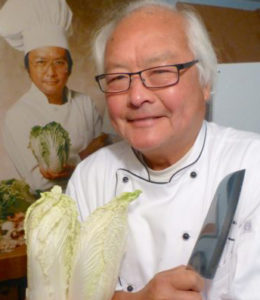Wok & Roll by Peter Kwong, (Frederic) Inter-County Leader
» Download this column as a Word document
I knew nothing about wines when I first attended college. Beer, yes; wine, nada.
It wasn’t until I got a job working as a waiter in a steakhouse that I had to learn about different wines and wine and food pairing. I couldn’t even pronounce the names, not to mention making recommendations to my customers.
Try to pronounce Chateauneuf du Pape without spitting all over someone’s face. So, I took the wine menu home, and actually studied it. I learned how to pronounce and describe the wines after many sleepless nights practicing.

“Yes sir, this particular cabernet sauvignon has flavors of black cherry and dark berry, with a hint of toasted oak; and it should complement nicely with your filet mignon.”
I was a working student, and couldn’t afford to pay $30 to $50 for a bottle of those expensive wine just for “educational purposes.” Lucky enough, the restaurant saved all the empty wine bottles (well, almost empty) so they could do an inventory every evening. And since the bartender and I were good friends, he would let me sit at the corner of the bar after my shift and taste whatever was left in the bottle.
I would write down on my notepad the name of the wine, the year it was made, the name of the vintner, and the country of origin. And most important, how my palate felt about that particular wine. And that, my dear friends, was the beginning of my journey of wine tasting.
There are many wines in the market — mostly red, white and pink. As the name implies, red wines are made from red grapes and white wines from white grapes. And pink is a mix of both red and white grapes (as in white zinfandel).
Wine is really a gift from the gods. We just pick the grapes off the vine, crush them and set them in a barrel. The yeast and the bacteria which live on the skin of the grapes will start to ferment. And slowly, it will turn the sugar in the grapes into alcohol and carbon dioxide. Of course, there is a lot more to the whole process, but in a nutshell, that’s how grapes turn to wine, through natural fermentation.
If you know nothing about wine, looking at a wine menu in a restaurant is most intimidating. Trying to figure out what wine will pair with your dinner becomes a scientific experiment. No worries. Follow these simple instructions and you can become a wine expert in no time flat.
The old days of “red wine goes with red meat (beef, pork, venison, etc.), and white wine goes with white meat (chicken, fish, shellfish, etc.) are forever gone. These days, the correct answer is “whatever your heart desires.” Actually, whenever I have salmon steak, I would rather serve it with a glass of light red wine — petite Sirah, or Pinot noir.
So, what to do to start learning about wines? Well, first learn about the differences in wines, mainly the red wines and the white wines. As I mentioned earlier, red wines are made with red grapes and white wines with white grapes.
Just like there are many kinds of tomatoes — cherry, heirloom, plum, roma, beefsteak … etc. — it is the same with grapes. For red grapes, there are varieties like Cabernet Sauvignon, Zinfandel, Pinot noir, Gamay Beaujolais, Shiraz, Merlot, Malbec and many others.
Each grape varietal has its own flavor and character. But somehow, depending on the region where it is grown, the profile is different from one to the other. Hence, the same grapes that are grown in Napa Valley in California might taste totally different than the grapes that are grown in New Zealand. The climate, the soil and the hours of sunshine every day can make a big difference.
As for the whites, there are Chardonnay, Sauvignon Blanc, Semillon, Muscato, Pinot Grigio, Gewurtztraminer, Riesling, and many others. When you look at the label of a wine bottle, you will notice:
- Vintner: The vinery that produces that wine — Fetzer, Kendall Jackson, Black Foxcellars, Murphy Goode, etc.
- Vintage: What year was it bottled? 2013, 2009, 1982? Rule of thumb is that the older the bottle, the better the quality because wine improves while aging.
- Varietal: What kind of grapes do they use? It varies by country, but the vintner must use 65 to 75 percent of the grapes of what the label states. Hence, if the bottle says Cabernet Sauvignon, it must contain 65 to 75 percent of Cabernet Sauvignon grapes, and the others can be a mix of any other grapes.
- Origin: France, Italy, Germany, California, Argentina, New Zealand, etc.
So now you have it. But what to do next? Just how do you pick the wine that you like?
Well, everyone has his/her own preferences. Some like wines that are full body and heavy, others like it light or a little sweet. The only way to know your wines is that you have to actually taste them.
Have fun. Salute, cheers, and gan bay!
Go to phkwong.com for more columns and to purchase his book, “Wok & Roll.”



